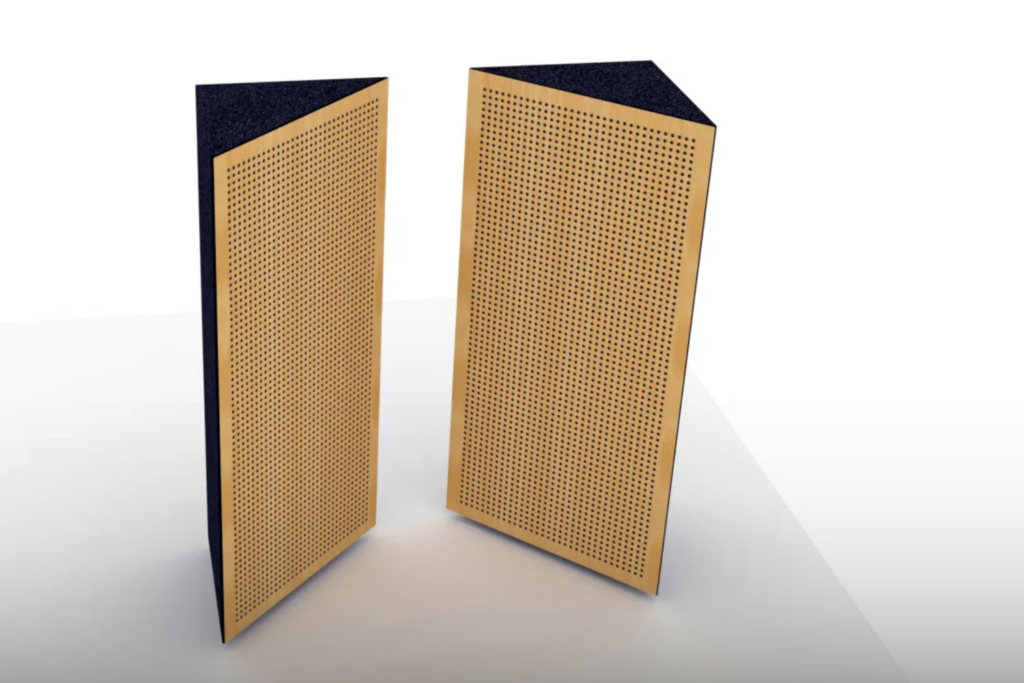When it comes to building a professional-sounding studio, you might be tempted to focus on gear like high-end microphones, audio interfaces, or even that beautiful set of studio monitors you’ve been eyeing. While all of these pieces are crucial, there’s a part of studio design that’s equally, if not more, important but often overlooked—acoustic treatment, especially bass traps.

In this article, we’ll dive into the world of bass traps, what they are, how they work, and why you absolutely need them in your studio to achieve a balanced, professional sound. Whether you’re working in a small home studio or a larger professional environment, bass traps play a crucial role in controlling low-frequency issues that can cloud your mix.
Contents
- 1 What Are Bass Traps?
- 2 Why Are Low Frequencies So Problematic?
- 3 How Do Bass Traps Work?
- 4 Placement Is Key: Where to Put Bass Traps
- 5 Types of Bass Traps
- 6 Do I Really Need Bass Traps in My Studio?
- 7 How Many Bass Traps Do I Need?
- 8 Bass Traps vs. Regular Acoustic Panels: What’s the Difference?
- 9 Calibration and Listening Tests
- 10 Don’t Forget the Rest of the Room
- 11 DIY Bass Traps vs. Store-Bought Options
- 12 Wrapping It Up: Invest in Your Sound
What Are Bass Traps?
Bass traps are a type of acoustic treatment designed specifically to absorb low-frequency sound waves, also known as bass. They’re called “traps” because they “trap” and neutralize excess bass that would otherwise reflect off the walls and corners of your studio, creating an unbalanced listening environment.
Low frequencies are notorious for being difficult to manage because of their long wavelengths. Unlike high frequencies that tend to be absorbed or reflected quickly by standard acoustic panels, bass frequencies can linger and bounce around the room, causing standing waves, room modes, and bass build-up—all of which muddy the clarity of your mixes.
Why Are Low Frequencies So Problematic?
To understand why bass traps are so crucial, you first need to know why low frequencies are so troublesome in untreated rooms. Low-end sound waves have much longer wavelengths compared to mid and high frequencies. For example, the wavelength of a 100 Hz bass note is about 11 feet (3.4 meters). These long wavelengths interact with the physical dimensions of your room, creating areas where certain frequencies are either amplified or canceled out, depending on how they reflect and interfere with each other.
In an untreated room, you’ll find that some areas may sound incredibly bass-heavy, while others seem to lack bass altogether. This inconsistency can make it difficult to accurately mix your music. You might compensate by adding more or less bass in your mix, only to realize later that it sounds completely different on other sound systems. This is where bass traps come in.
How Do Bass Traps Work?
Bass traps are specifically designed to absorb and neutralize low-frequency sound energy. But how exactly do they do that?
- Absorption Mechanism: Bass traps absorb sound energy by converting it into a small amount of heat. This is done through friction as the sound waves pass through the porous material that makes up the bass trap. The thicker and denser the material, the more effective it is at absorbing lower frequencies.
- Porous Absorbers: Most bass traps use dense, fibrous materials like fiberglass, mineral wool, or open-cell foam, which allow sound waves to penetrate. As the sound passes through, the material resists the movement of air particles, reducing the energy of the sound wave.
- Resonant Absorbers: Some bass traps, like membrane or panel absorbers, use a different approach. Tuned to resonate at specific low frequencies, the vibrating membrane absorbs and dissipates the energy when these frequencies strike the trap. This method is especially effective for targeting very specific problem frequencies.
Placement Is Key: Where to Put Bass Traps
The effectiveness of bass traps depends not only on their quality but also on where you place them. You can’t just throw them up randomly and hope for the best! Bass tends to accumulate in the corners of a room, both vertically and horizontally. This is because sound waves reflect off walls and surfaces and meet at these junctions, intensifying the low-end build-up.
Here’s where you should focus on placing your bass traps:
- Corners of the Room (Tri-corner Placement): The corners where two walls and the ceiling or floor meet are prime spots for bass build-up. Tri-corner traps, which are designed to fit snugly into these areas, are particularly effective.
- Wall-to-Wall Corners: The vertical corners of your room are also hotspots for bass energy. Placing bass traps here can reduce the low-frequency resonance that builds up and smooth out the bass response.
- Behind the Listening Position: Bass waves reflect off the back wall of your studio and can interfere with the sound coming from your monitors. Placing bass traps here helps absorb those reflections and creates a more accurate listening environment.
Types of Bass Traps
There are several types of bass traps available, and each has its strengths depending on your studio’s needs.
1. Porous Absorbers
Porous absorbers are the most common type of bass traps and are made from materials like foam or fiberglass. They’re generally inexpensive, easy to install, and effective for a wide range of frequencies. These traps work by allowing sound waves to enter and then dissipating the energy within the material.
- Pros:
- Effective for a broad range of low frequencies.
- Budget-friendly.
- Easy to install.
- Cons:
- May require a lot of surface area to be truly effective for very low frequencies (below 80 Hz).
2. Membrane Bass Traps
Membrane traps, or resonant traps, consist of a stretched membrane over a sealed cavity. They are often tuned to absorb specific problem frequencies and are more efficient at targeting very low bass frequencies.
- Pros:
- Highly effective for specific low-end problem frequencies.
- Can be compact and unobtrusive.
- Cons:
- Typically more expensive than porous absorbers.
- Need to be tuned properly to your room’s acoustics.
3. Diaphragmatic Absorbers
These are more advanced bass traps that use a rigid diaphragm, like wood or metal, to absorb bass frequencies. Diaphragmatic absorbers are incredibly efficient at absorbing low-end energy, but they are usually bulky and expensive.
- Pros:
- Excellent for absorbing very low frequencies.
- Highly efficient, even in small sizes.
- Cons:
- Costly and can be difficult to build.
- Heavy and harder to install compared to other types.
Do I Really Need Bass Traps in My Studio?
If you’re serious about mixing and producing music that translates well across different listening environments, the answer is a resounding yes. You can have the best monitors, but without controlling the acoustics of your room, especially the bass, your mixes will always sound inconsistent.
Here are some signs you might need bass traps:
- Inconsistent bass response: If the bass sounds strong in one part of the room and weak in another, bass traps will help even out the response.
- Muddy low-end: When bass frequencies mask other elements in your mix, making the low-end sound muddy or undefined, this can often be a result of excess bass build-up.
- Poor translation: If your mixes sound great in your studio but fall apart when played in the car, on headphones, or other environments, bass traps can help you get a more accurate sense of your mix in the studio.
How Many Bass Traps Do I Need?
The number of bass traps you need will depend on the size of your room and its specific acoustic issues. As a general rule, you can never really have too much bass trapping—low frequencies are stubborn and tend to pile up in untreated spaces. If you’re working in a small home studio, a good starting point is to place bass traps in all four vertical corners and consider adding more to the tri-corners (where walls meet the ceiling or floor). For larger spaces, you may need more traps to effectively manage the room’s low-end energy.
Bass Traps vs. Regular Acoustic Panels: What’s the Difference?
It’s important to note that not all acoustic panels are designed to absorb bass frequencies. Regular acoustic panels (typically 2 to 4 inches thick) are great for absorbing mid and high frequencies, which help reduce flutter echoes and general reverberation. However, they are not thick or dense enough to deal with low-end issues effectively.
Bass traps, on the other hand, are specifically engineered for low frequencies. They are often thicker, denser, and placed strategically in areas where low-end energy accumulates. While you’ll still want regular acoustic panels to treat mid and high frequencies, bass traps are essential for taming the low-end.
Calibration and Listening Tests
After installing bass traps, it’s important to calibrate your listening environment and conduct listening tests to ensure that your room sounds balanced. Calibration involves using software or a hardware system to measure the frequency response of your room and adjust your monitors accordingly. However, the real test comes from how well your mixes translate to different environments—headphones, car speakers, home systems, and other rooms.
Once the bass traps are installed, sit in your mixing sweet spot (the optimal listening position in front of your monitors) and play music you’re familiar with. You should immediately notice a difference in how the low-end feels. It should sound tighter, more controlled, and less boomy or muddy.
Don’t Forget the Rest of the Room
While bass traps are incredibly effective for taming low frequencies, they’re only part of the solution. To create a well-balanced acoustic environment, you’ll also need to address the mid and high frequencies in your room. Acoustic panels and diffusers can help reduce echoes and reverb in the higher frequency ranges, allowing you to hear your mixes more clearly.
- Acoustic Panels: These are great for absorbing mid and high frequencies. Place them on the side walls and ceiling to control reflections and create a “dead” space in your mix position.
- Diffusers: Instead of absorbing sound, diffusers scatter sound waves. This can be helpful for larger studios to retain a sense of space and air in the room without over-dampening the sound.
DIY Bass Traps vs. Store-Bought Options
If you’re on a tight budget, you can even build your own bass traps using materials like mineral wool or fiberglass insulation. There are plenty of DIY tutorials online that can guide you through building effective bass traps for a fraction of the cost of buying them pre-made. The key is to use dense, thick materials that can handle low-frequency absorption.
However, if you prefer something more polished and professional, many companies offer high-quality, aesthetically pleasing bass traps that are easy to install. Some even offer customizable options to match your studio’s decor.
Wrapping It Up: Invest in Your Sound
In conclusion, bass traps are an essential element of any studio setup. Whether you’re working in a small bedroom studio or a larger professional environment, controlling low frequencies will vastly improve the accuracy of your mixes. While it may seem like an extra expense, consider it an investment in your sound and career.
By understanding how bass traps work and where to place them, you can avoid the common pitfalls of untreated rooms—like muddy low-end, poor translation, and inconsistent bass response. Once you’ve treated your room with bass traps, you’ll experience a clearer, more detailed sound that lets your mixes shine on any sound system.
If you’ve never experienced the difference bass traps can make, trust me—once you have them properly installed, you’ll be amazed at how much clearer and more defined your mixes become.












![The 6 Best Digital Audio Workstations (DAWs) for Your Home Studio [2024] 3 Best DAWs](https://musicfevr.com/wp-content/uploads/2024/10/Best-DAWs.jpg)

